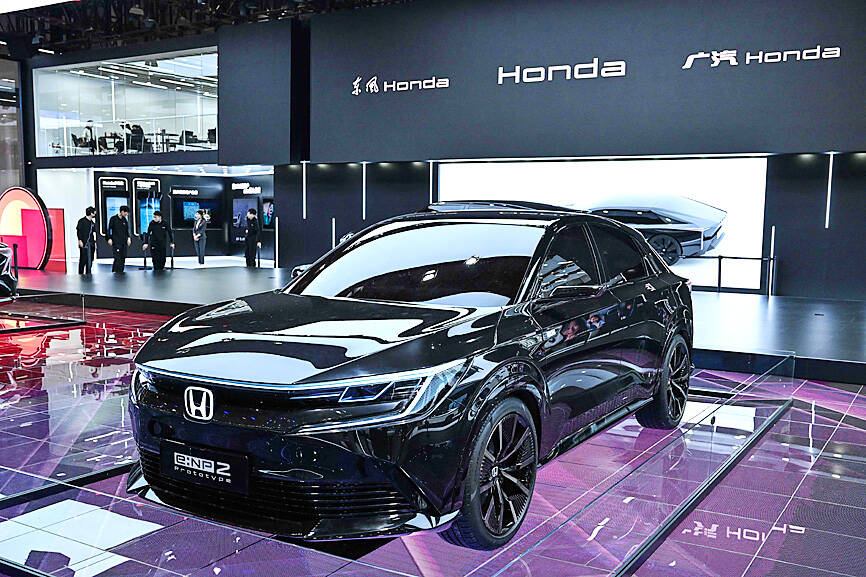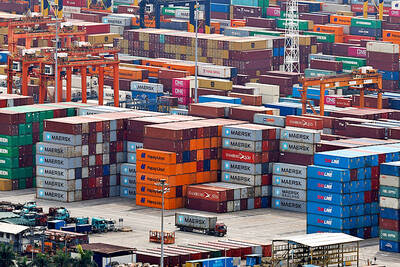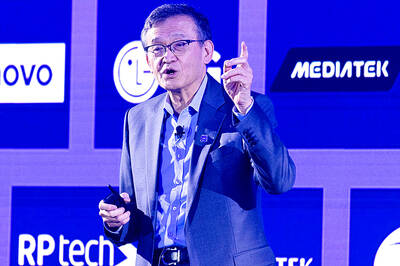Honda Motor Co is gearing up for an electrification shift in North America with two models developed with General Motors Co going on sale next year and a bigger electric vehicle (EV) with a new platform in 2025, a year earlier than initially announced.
“We believe that the value society places on being kind to the environment will only build in momentum,” Honda president Toshihiro Mibe said yesterday in announcing a sprawling set of initiatives intended to put the automaker on the global EV map.
Mibe told reporters that Tokyo-based Honda would forge ahead on investments and partnerships to realize such goals.

Photo: AFP
Honda has set a goal to offer all its models around the world as EVs or equipped with fuel cells, which run on hydrogen and are emissions-free, by 2040. It aims to make more than 2 million EVs a year by 2030.
In Japan, where EV demand is picking up gradually, an EV based on the N-ONE model goes on sale in 2025. Two more EV models are planned for the following year.
In China, the world’s biggest EV market, the Japanese automaker has three electic models going on sale next year — the e:NS2, the e:NP2 and a concept unveiled at Auto Shanghai last week.
Honda said it would introduce seven more EV models in China by 2027.
By 2035, Honda aims for 100 percent EVs for its China sales, ahead of other regions.
All the world’s automakers are getting serious about EVs, now dominated by Tesla Inc and China’s BYD Co (比亞迪). With governments moving to curb emissions and climate change, even previously skeptical consumers are starting to buy EVs, especially in the US and China, but also in parts of Europe and in Australia.
The big question is whether Japanese manufacturers, such as Honda and Toyota Motor Corp, would be able to dominate the market as they have historically with gasoline-powered vehicles.
The main drawback for the proliferation of EVs is the battery, which is heavy, a challenge in auto development. The components needed to make batteries, such as rare earths, are expensive.
Honda plans to leverage its strategic partnership with Hanwa Co, a Japanese trading company, to ensure stable procurement of nickel, cobalt and lithium for batteries, Mibe said.
In North America, Honda would use batteries from General Motors and a joint venture with South Korea’s LG Energy Solution. Honda would make electric models in the US at its three plants in Ohio, including the Marysville plant.
Under the US’ Inflation Reduction Act, signed by US President Joe Biden last year, to qualify for full tax credits, EVs must be assembled in North America, and a certain percentage of their battery parts and minerals have to come from North America or a US free-trade partner.
Honda is also working on developing solid-state batteries for EVs, Mibe said.
EVs now run mostly on lithium-ion batteries.
Honda’s 2025 platform is called “E&E architecture,” for “electric and electronic,” referring to the software, connectivity and services that work while driving and are updated over time.
Automakers are expected to be competing in this area.
Mibe said Honda has dealt with the recent shortage of computer chips that have hit all automakers, partly due to restrictions related to the COVID-19 pandemic.
Honda has reached a basic agreement with Taiwan Semiconductor Manufacturing Co (TSMC, 台積電), the world’s largest semiconductor maker, to guard against such shortages in the future.
“We hope to lead the world in ecological manufacturing,” Mibe said.

The Eurovision Song Contest has seen a surge in punter interest at the bookmakers, becoming a major betting event, experts said ahead of last night’s giant glamfest in Basel. “Eurovision has quietly become one of the biggest betting events of the year,” said Tomi Huttunen, senior manager of the Online Computer Finland (OCS) betting and casino platform. Betting sites have long been used to gauge which way voters might be leaning ahead of the world’s biggest televised live music event. However, bookmakers highlight a huge increase in engagement in recent years — and this year in particular. “We’ve already passed 2023’s total activity and

Nvidia Corp CEO Jensen Huang (黃仁勳) today announced that his company has selected "Beitou Shilin" in Taipei for its new Taiwan office, called Nvidia Constellation, putting an end to months of speculation. Industry sources have said that the tech giant has been eyeing the Beitou Shilin Science Park as the site of its new overseas headquarters, and speculated that the new headquarters would be built on two plots of land designated as "T17" and "T18," which span 3.89 hectares in the park. "I think it's time for us to reveal one of the largest products we've ever built," Huang said near the

China yesterday announced anti-dumping duties as high as 74.9 percent on imports of polyoxymethylene (POM) copolymers, a type of engineering plastic, from Taiwan, the US, the EU and Japan. The Chinese Ministry of Commerce’s findings conclude a probe launched in May last year, shortly after the US sharply increased tariffs on Chinese electric vehicles, computer chips and other imports. POM copolymers can partially replace metals such as copper and zinc, and have various applications, including in auto parts, electronics and medical equipment, the Chinese ministry has said. In January, it said initial investigations had determined that dumping was taking place, and implemented preliminary

Intel Corp yesterday reinforced its determination to strengthen its partnerships with Taiwan’s ecosystem partners including original-electronic-manufacturing (OEM) companies such as Hon Hai Precision Industry Co (鴻海精密) and chipmaker United Microelectronics Corp (UMC, 聯電). “Tonight marks a new beginning. We renew our new partnership with Taiwan ecosystem,” Intel new chief executive officer Tan Lip-bu (陳立武) said at a dinner with representatives from the company’s local partners, celebrating the 40th anniversary of the US chip giant’s presence in Taiwan. Tan took the reins at Intel six weeks ago aiming to reform the chipmaker and revive its past glory. This is the first time Tan